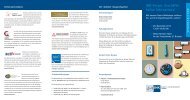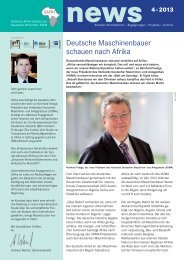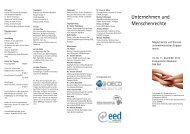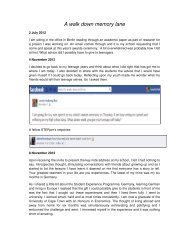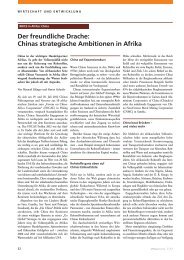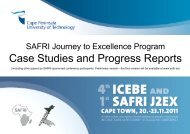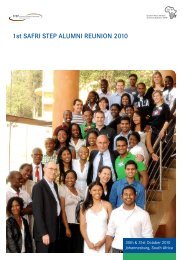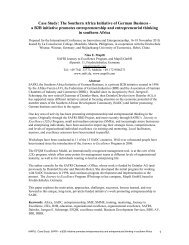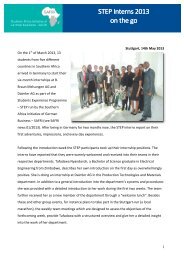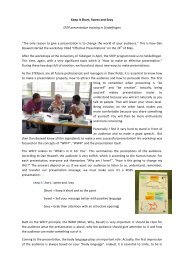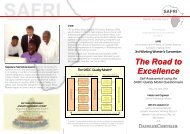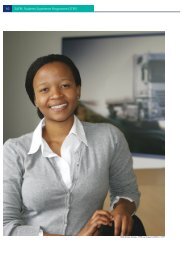conference programme - icebe.net
conference programme - icebe.net
conference programme - icebe.net
You also want an ePaper? Increase the reach of your titles
YUMPU automatically turns print PDFs into web optimized ePapers that Google loves.
Paper Abstracts—In Alphabetical Order of Presenters<br />
51<br />
SOUTH AFRICA’S CHANGING TEACHER EDUCATION POLICY<br />
FRAMEWORK AND ITS IMPLICATIONS FOR BUSINESS AND<br />
ENGINEERING EDUCATION<br />
ANDRE VAN DER BIJL<br />
Cape Peninsula University of Technology, Cape Town, South Africa<br />
Email: vanderbijla@cput.ac.za<br />
Tel: + 27 21 680 1500<br />
ABSTRACT<br />
South Africa has a comprehensive policy framework for teacher<br />
education. Although the framework’s comprehensiveness is partly<br />
the result of detailed structural differentiation of teacher education<br />
before 1994, its current structure is largely the result of the efforts of<br />
policy makers since 1994.<br />
Prior to 1994 the primary focus in training educators for business<br />
and engineering was in developing teachers for high schools. As<br />
technical colleges were resuscitated following their upgrading to<br />
technikons, the schools policy framework was simply extended to<br />
college educators. Since 1994 the framework recognising educator<br />
qualifications has been revised twice, and envisage is a framework<br />
for teachers in schools and another for further education and training<br />
college (FETC) staff.<br />
Business and engineering education has posed a perennial challenge<br />
for teacher education policy makers. Due to a shortage in<br />
business teachers business teacher education <strong>programme</strong>s have<br />
been in exiting since the 1970s. Similarly, the tendency for artisans<br />
to seek employment in education later in life resulted in the development<br />
of dedicated, in-service-based <strong>programme</strong>s, for people employed<br />
in technical high schools and FET colleges. As a result, two<br />
separate routes exist for business educators and three for engineering<br />
students. Although the proposed frameworks expand the entry<br />
possibilities for business and engineering graduates they also create<br />
challenges. These include appropriate knowledge and portability<br />
of qualifications.<br />
A NEW “5E+3C” EDUCATION PATTERN OF INNOVATIVE AND<br />
APPLIED TALENTS<br />
WANG LISHENG, XIAO YING, LI JIA, TAO LONGFENG<br />
Shijiazhuang University of Economics, Shijiazhuang, 050031, China<br />
ABSTRACT<br />
The new education pattern is called “5E+3C”. “5E” referring to five<br />
qualities of the students which we target at in our education. The<br />
first E stands for the Engine, which means a motivation of a student<br />
like a motor engine providing inner driving force. The second E<br />
represents Essential, which indicates the necessary basic knowledge<br />
and theories the students should master. The third E refers to<br />
Exercise , which can be interpreted as the operating abilities. The<br />
fourth E expresses Exploration, which means the spirits of tracing,<br />
research and exploration. The last E stresses Entrepreneurship,<br />
which refers to the quality of entrepreneurship. “3C” means that we<br />
should provide students with three kinds of teaching resources and<br />
services. The first C is the short form of Condition. We should provide<br />
students with good learning and teaching conditions. The second<br />
C is the short form of Chance. We should provide students with<br />
opportunities to take full advantage of the conditions. The third C is<br />
the short form of Conduct. We should provide students with scientific,<br />
rational and efficient guidance.<br />
Key words innovative and applied talents, education pattern,<br />
gemmology and material technique, 5E+3C



